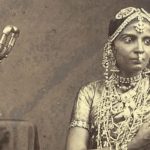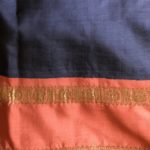motif
məʊˈtiːf/
noun
- decorative image or design, especially a repeated one forming a pattern.
- a dominant or recurring idea in an artistic work.
As with much in traditional India, motifs in Kanchipuram sarees echoed the ethos of the land and its people. Many of the motifs were drawn from nature and were recurrent themes in temples, bronze sculptures, paintings and textiles. The famed annapakshi motif, for instance, is found in brass lamps, kalamkari hand-painted scrolls, Tanjore paintings, jewellery and terracotta ware.
Most motifs served a few purposes. They were elements of decoration and symbols of fertility and prosperity. They reflected mythical stories with birds and animals. They were rooted in the divine such as the rudraksh beads that were the prayer beads for Lord Shiva. Most important of all, they possessed a symmetry and length that suited weaving traditions. The creeper-vines (valli), anklets (golusu) and pearls (muthu-kattam) were narrow, long and seemed to stretch towards eternity or at least till the breadth of the border.
The genius of Kanchipuram weavers was not just in the choice of the motifs, but also in the way that these motifs were put together in the saree. As Sri. Krishnamoorthy, master weaver and national award winner says, “It is not just about a single motif. Each is an ecosystem and sometimes how to border the main motif is just as important as the motif itself. How you combine different motifs in the saree, how you enhance the motifs with choices of colour and embellishments. That is the beauty of a Kanchipuram saree.”
Hear them Spoken
The Motifs
- Annapakshi: Arguably the most important motif. This mythical bird is said to have descended from the heavens. It has the plumage of a peacock and the body of a swan. Called hamsa or annapakshi, this mythical bird symbolizes fidelity– somewhat akin to the chakravaha birds in Sanskrit literature which mate for life. Naturally, people wanted to have such a motif in the wedding saree of their daughter. The other attribute of the hamsa as this bird is called is discernment: it can separate milk from water. Perhaps the weavers hope that their customers will have such discernment in separating handwoven sarees from their synthetic counterparts.
- Rudraksham: seeds of the Elaeocarpus ganitrus tree that are used as prayer beads of Lord Shiva. In Tamil, these seeds are called “Thirukanmani” or the eyes of Lord Shiva. Worn by ascetics around their necks, the nubby shape of these seeds inspired weavers to translate them on the looms.
- Kamalam: Lotus flower
- Thuthiri Poo: A mixture of flowers
- Lavanga poo: Clover
- Sampangi poo: Magnolia champaka flower
- Madhula Moggu: Pomegranate bud
- Pullaiyar Moggu: Looks like a turmeric ganesha
- Mayil kann: Peacock’s eye. Does not have a dot in the middle.
- Kuyil Kann: Koel’s eye. Has a dot in the middle.
- Puli nagam: tiger’s claw
- Bogudi kodi: creeper or Bogudi vine.
- Arai bogudi: half vine or creeper
- Vanki: a curved armband worn above the elbow.
- Golusu: anklets
- Kumbam: the conical structure on top of a South Indian temple
- Kalasham: A puja decoration that has a pot with a coconut on top and mango leaves
- Then thuli: drops of honey
- Paiadi or Paimadi: a honeycomb like pattern of a handwoven mat
- Cheepu reku: comb like temple
- Thazham poo reku: kewda flower like border
- Rettai nelli: two vine-like creepers
- Othai nelli: one vine-like creeper
Besides these, there are many other names like arumbu, moggu, pirai maadam, film pettu, charadu, chaavi, arai mangai, kathir, then koodu, and then some.
Watch Smt. Sasikala of the Weaver’s Service Centre, Kanchipuram speak about the traditional motifs of Kanchipuram here





